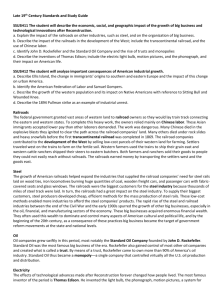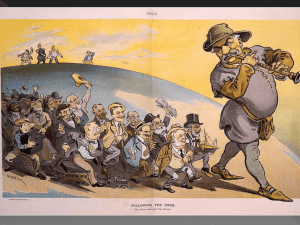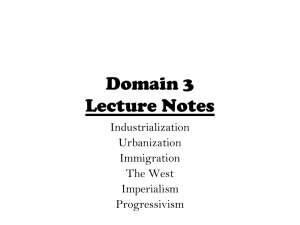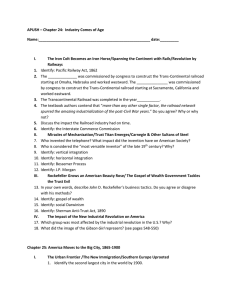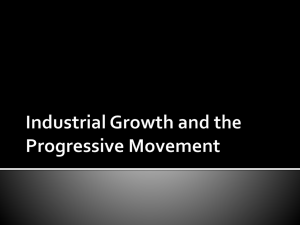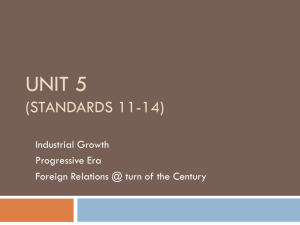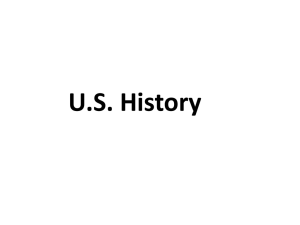Standard 11-14
advertisement
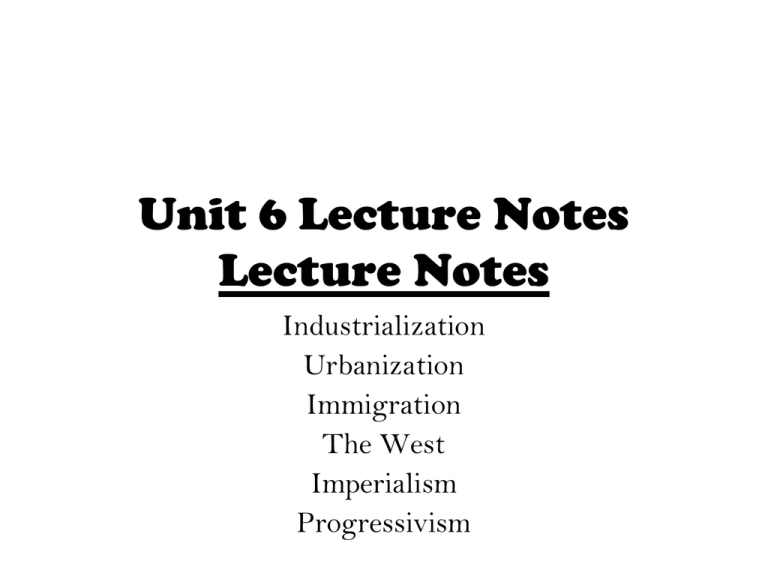
Unit 6 Lecture Notes Lecture Notes Industrialization Urbanization Immigration The West Imperialism Progressivism Standard 11 • SSUSH11 The student will describe the economic, social, and geographic impact of the growth of big business and technological innovations after Reconstruction. • a. Explain the impact of the railroads on other industries, such as steel, and on the organization of big business. • b. Describe the impact of the railroads in the development of the West; include the transcontinental railroad, and the use of Chinese labor. • c. Identify John D. Rockefeller and the Standard Oil Company and the rise of trusts and monopolies • d. Describe the inventions of Thomas Edison; include the electric light bulb, motion pictures, and the phonograph, and their impact on American life Railroads • The Federal government gave tons and tons of western lands to railroad owners so they would lay track and connect the states • Land Grants went hand in hand with considerable government corruption in the post-Reconstruction United States – Credit Mobilier • Railroad owners like Cornelius Vanderbilt rose to tremendous power • What are the benefits and drawbacks to the expansion of the railroads? Working On The Railroad • To complete the heavy work, Chinese labor was hugely important – “Coolies” accepted lower pay for dangerous jobs; many died in explosions, rock slides, snowfalls, etc • The use of Chinese labor to build railroads in the west west had a major social backlash. • Why might the Chinese workers be the targets of racism in the West? Transcontinental Railroad • May 10, 1869, with a golden spike the Union Pacific RR and the Central Pacific RR met at Promontory Point, Utah to complete the first railroad that covered the US from coast-tocoast • How is this achievement good for farming and business in the US? Western Development • The Pacific Railway Acts of 1862 granted land to railroad companies to build the transcontinental railroad. Then the railroads helped develop the West by selling low-cost parcels of fertile land to farmers settling – Land that was given to them by the federal government • Farmers used the RR to ship grain or cattle back east…at a price • The expansion of the railroad industry in the 1800’s was a was a positive development for other industries, like steel, Electricity • From his research laboratories in New Jersey, Thomas Alva Edison forever changed how people lived with the light bulb, phonograph, motion pictures, electric power generator, and many others • Edison’s inventions opened possibilities, with electrification of factories, urban buildings, streetlights, streetcars, and all of the electric appliances across entire neighborhoods • Most of Thomas Edison’s patents were utility patents, that is, improvements upon existing inventions. Edison’s light bulb would not have become a commercial success without a system to generate and distribute electricity. Steel Industry • RR growth fed a need for more steel for the thousands of miles of rail track – In 1860: 13,000 tons of steel produced in US – In 1880: 1,400,000 tons of steel produced • The new Bessemer Process created cheap, efficient methods for mass producing steel • Andrew Carnegie was a master organizer who became very wealthy in the steel industry, but also believed in distributing that wealth back in the community • “The Gospel of Wealth”, encouraged wealthy people to use their money to benefit society. • Other than the railroads, how else can steel help the • Where is this cartoon set? • Who are the characters to the back? • Who are the characters to the front? • What is this cartoonist’s opinion? John D. Rockefeller • Founder of Standard Oil Company • Strong belief in Social Darwinism, that “only the strong survive” in natural capitalism • “Pay nobody a profit” • He believed that competition ruined business by forcing prices down • What could be the negative consequences of Rockefeller’s business actions? What did John D. Rockefeller create in order to monopolize the oil industry? Standard Oil Company • The most famous business of the Gilded Age • Rockefeller gained control of competing companies to form a trust • Owning over 90% of the oil industry in America, it can be said that he had a monopoly – where he virtually controlled all oil production and distribution • Standard oil attained its immense wealth by consolidating power, taking over competitors, and becoming a monopoly. Monopoly • Vertical Integration – Andrew Carnegie’s steel company would own the mines where the coal and iron ore was extracted, the ships and railroads that transported the materials, as well as the mills and factories for producing the steel. • Horizontal Integration – Rockefeller would buy out all competing businesses to make sure he owned everything • Robber Barons – wealthy business owners who often engaged in unfair or anti-competitive business practices What was the relationship between big business and government like? Henry Ford Sam Walton Cornelius Vanderbilt John D. Rockefeller $192,000,000,000 Andrew Carnegie Bill Gates $82,000,000,000 Standard 12 • SSUSH12 The student will analyze important consequences of American industrial growth. • a. Describe Ellis Island, the change in immigrants’ origins to southern and eastern Europe and the • impact of this change on urban America. • b. Identify the American Federation of Labor and Samuel Gompers. • c. Describe the growth of the western population and its impact on Native Americans with reference to Sitting Bull and Wounded Knee. • d. Describe the 1894 Pullman strike as an example of industrial unrest. New Immigrants • In the past, most European immigrants had come from northern and western Europe (and were English-speaking Protestants) • The New Immigrants of the late 19th century came from eastern & southern Europe (and many were non-English-speaking Jews and Catholics) – New Immigrants usually settled in urban areas populated by people from their same homeland and settled here as unskilled laborers • What was an effect of the characteristics listed above? Ellis Island • Immigrant Station in New York Harbor – Angel Island in San Francisco Bay for Asian immigrants • Between 1870 and 1920, approximately 20 million Europeans passed through the Golden Door • The poorer immigrants had to pass health, education, and welfare tests in order to gain access to the US • What does America offer these immigrants? Nativism • Many Americans were not open to the “melting pot” idea of the US and some strong anti-immigrant feelings grew • Chinese laborers in the West and along the railroads faced racism and violence • What are some reasons for the nativist feelings in America’s cities? Chinese Exclusion Act • In 1882, Congress passed the law to ban all future Chinese immigration to the US • Japanese Americans also faced racial prejudice, as there were laws against them buying land or gaining citizenship • Why didn’t the US pass laws against British, Polish, Italian or Ukrainian immigrants? American Federation of Labor • In the late 1800s, labor unions were formed improve working conditions for workers. • Samuel Gompers was the president of the AFL from 1886-1894, 1895-1924 (38yrs!) • Unskilled workers got low wages, long workdays, no vacations & unsafe workplaces • The individual worker had no voice • Collective bargaining from a union gave the poor workers some weight and power • What can the workers of a labor union do to get a response from their employer? The Lakota • In 1868, the United States and the Lakota tribe signed the Treaty of Fort Laramie, which granted the Lakota ownership of the Black Hills in South Dakota and Wyoming. – During the 1870s, many settlers moved into the area owned by the Lakota, disregarding the treaty • Why were the settlers so interested in this land? Sitting Bull • As the East became more industrialized after the Civil War, many Americans pushed west in search of simpler rural lives • The US agreed with Sioux leader Sitting Bull that “no white person or persons shall be permitted to settle upon or occupy” Sioux lands – But when gold is discovered…negotiations give way to fighting…10 years later Sitting Bull died in a brief gun battle • What other historical American Indian leaders does Sitting Bull remind us of? Wounded Knee • Prior to Sitting Bull’s death, many Sioux became involved in a religious movement called the Ghost Dance that they believed would cleanse the world of evil (USA?) • After Sitting Bull’s death, these highly motivated Sioux fled to Wounded Knee and the US army followed and a battle ensued – 300 Sioux were killed – The Indian Wars were forever over • The last armed conflict to take place between the Native Americans and the U.S. Army Pullman, Illinois Pullman, Illinois Pullman Strike • During the poor economic times of the 1870s, 1880s, and 1890s, violence was common when employers fired workers or lowered their wages • In 1894, when the Pullman railcar factory near Chicago fired ½ of its workers and cut wages 2550%, rail traffic through Chicago came to a halt due to the striking workers that had become violent • President Grover Cleveland sent the US Army in to restore peace and quiet the striking workers’ labor union • Why did the president take the side of George Pullman instead of the workers? Standard 13 • SSUSH13 The student will identify major efforts to reform American society and politics in the Progressive Era. • a. Explain Upton Sinclair’s The Jungle and federal oversight of the meatpacking industry. • b. Identify Jane Addams and Hull House and describe the role of women in reform movements. • c. Describe the rise of Jim Crow, Plessy v. Ferguson, and the emergence of the NAACP. • d. Explain Ida Tarbell’s role as a muckraker. • e. Describe the significance of progressive reforms such as the initiative, recall, and referendum; direct election of senators; reform of labor laws; and efforts to improve living conditions for the poor in cities. • f. Describe the conservation movement and the development of national parks and forests; include the role of Theodore Roosevelt. Muckrakers • Journalists that investigated and exposed political corruption, child labor conditions, city slums, and other social issues • What’s the matter with someone who complains all the time? Ida Tarbell • In a series of magazine articles, she exposed political corruption in major US cities • Her most famous work is The History of Standard Oil Company, in which she describes the unfair business practices • Congress was pushed to break up the Standard Oil Trust • Did muckrakers help make America better? Upton Sinclair • His novel, The Jungle, tells the story of European immigrants working in Chicago’s meatpacking industry • It exposed poor labor practices and unsanitary conditions that produced contaminated food • Congress was pushed to pass laws like the Meat Inspection Act and Pure Food & Drug Act • What was the cause and the effect of the publication of The Jungle? Hull House • Women were particularly involved in the Progressive movement • Jane Addams borrowed a British idea, the settlement house, which was a social service agency that provided trained workers for recent immigrants and working-class people in the cities – Taught economics, brought medical care, child care, taught English, gave legal advice, gave job training, etc • Is effective change in society better created by the government or by the actual people living in the community? Progressive Reforms • The Progressives were in search of improvements to people’s lives – The Gilded Age left many feeling out of reach of the American Dream • Supported: increased government regulation of business & industry; efforts to protect consumers; conservation; • What kind of president would be perfect for America at this time? Initiative • Since political bosses had taken away the power of the people in the American democracy, Progressives tried to increase the role of the ordinary citizen in government • For example, supporters of new laws could collect voters’ signatures to force a public vote on the issue that could become law • What kinds of Americans were probably most likely to participate in an initiative? Referendum • Once enough citizens supported the initiative, the government could put the issue up for a public vote • This vote would be known as the referendum – where the people decide for themselves whether or not the issue needed to be passed as a law • If the people pass the law, who are they saying they don’t trust to do it? Recall • If a government official was too corrupt or too unwilling to act on the people’s needs, then the citizens could remove the official by public vote before the term was up • What was happening to the Gilded Age political bosses during the Progressive era? 17th Amendment • In 1913, the 17th Amendment was passed to give the citizens of the US the power to elect their state’s two senators – In the past, other government workers and party officials had had control over selecting senators • What do the 15th and 17th Amendments all have in common? Economic Reforms • State child labor laws set a minimum age for employment and restricted the types of jobs that children could hold. • State laws were also passed to protect women by setting a minimum wage and laws that created maximum hours. • Work site inspections to insure health, safety, and sanitation. Jim Crow Laws • Even though Radicals in Congress had tried to fix civil rights during Reconstruction, resistance had made progress s l o w • Southern states had passed segregation laws that required separate public & private facilities for black Americans • These laws resulted in inferior education, health care, and transportation systems for blacks • Since, the 14th Amendment had guaranteed equal treatment of all citizens, how can these laws be legal? Plessy v. Ferguson • These controversial Jim Crow laws were constitutionality upheld in the Supreme Court case of Plessy v. Ferguson. • Homer Plessy (1/8th African American). Arrested for refusing to leave a whites only railroad car. – Using the “separate but equal” doctrine, the Court ruled racial segregation was legal in public accommodations such as railroad cars. • What might be a possible problem with the doctrine of “separate but equal”? NAACP • The National Association for the Advancement of Colored People was formed to seek full social & economic equality for blacks • Founded by W.E.B. Du Bois, Ida B. Wells, and many others. • The organization quickly began to challenge Jim Crow laws and lynching through the courts. • Who helped found the NAACP? Imperialism • In the last decades of the 19th century, some Americans were eager to spread democracy into Latin America and other world regions. • Other Americans argued that American expansion was not the best way to spread America’s democratic traditions. Spanish American War • In 1898, the United States went to a splendid little war (it lasted less than four months) with Spain after the Spanish refused to grant independence to rebels fighting a revolutionary war in Cuba. • Riots broke out in Havana. – The sinking of the Maine • Supporters of American expansion were eager to gain U.S. territory in Latin America, leading to a “war fever”. – Remember the Maine! • The Spanish were driven out of Cuba, which became an independent country closely watched by the US, and out of Puerto Rico, which became an American territory. The Philippines • Along with battles in Cuba, other battles of the Spanish-American War took place in the Philippines, another Spanish colony. • The U.S. Navy quickly defeated the Spanish navy, and Americans debated whether the United States should take over or respect Filipino independence. – Decision? Spain sold the Philippine Islands to the U.S. for $20 million dollars. • The Philippine-American War broke out after the US decided to hang onto the Pacific islands. – Promised independence in 1916; did not arrive till 1946. Roosevelt Corollary • The Caribbean and Latin America were unstable. • Many countries owed large amounts of money to European countries and US President Theodore Roosevelt feared European countries would take advantage of this instability to gain power and influence in the region. • TR announced to the world that the United States had the right to intervene in Latin American countries in economic crisis, an addition to the old Monroe Doctrine. Conservation Movement • Emerged in the 1870s. • First, businesses supported laissez-faire • Second, environmentalists believed that nature was scared and humans were intruders. • Roosevelt increased national reserves of forests. Panama Canal • America now controlled territory in the Atlantic and in the Pacific Oceans and wanted a faster sea route from the Atlantic to the Pacific – Instead of traveling around the southern tip of South America, • The U.S. built a shipping canal across the narrow Central American country of Panama in what was the biggest engineering project of the era. – When the Panama Canal opened in 1914, a voyage from San Francisco to New York was cut from 14,000 miles to 6,000 miles. • How will this canal help America?
